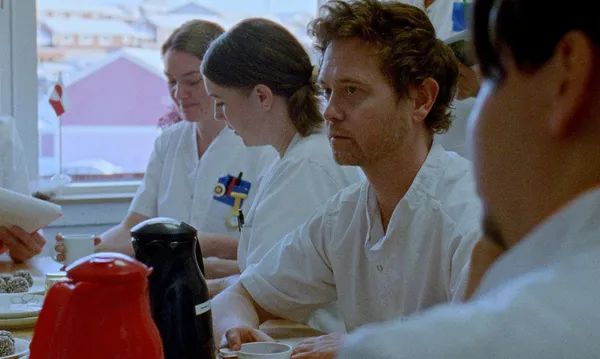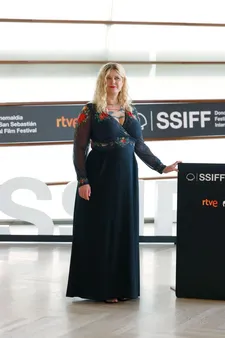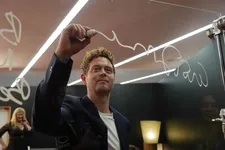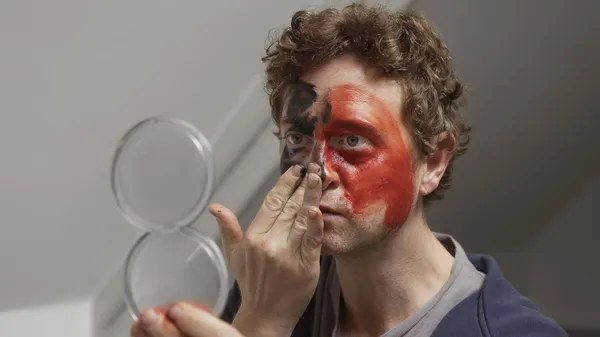 |
| Emil Johnsen as Jan in Kalak. Isabella Eklöf: 'When you don’t address your pain, you just make it worse. So you spread it' Photo: Manna Film |
Isabella Eklöf’s latest film Kalak is a loose adaptation of the autobiography by Danish-Norwegian author Kim Leine - who helped write the script along with Eklöf and Sissel Dalsgaard Thomsen. It’s a tough and raw watch that tracks Jan (Emil Johnsen), a nurse who was abused by his father (Søren Hellerup), whose lingering trauma makes his life in Greenland with his family become increasingly unstable.
Although it is a personal work, the Swedish filmmaker, who sat down for a chat with us after the film's world premiere in competition at San Sebastian Film Festival, says she took a robust approach.
 |
| Isabella Eklöf: 'There's stuff in the film that did not happen to him, but that happened to me' Photo: Iñaki Luis |
“I don't think I need to respect his personal story, to be honest, because we are very aware that it’s a piece of cinema. It's not a book, and it's not his autobiography. We took extra care to make sure that this was clear by renaming the character to something similar, but not the same thing. And bringing in my personal stuff. There's stuff in the film that did not happen to him, but that happened to me. And that's okay because it's not a true story. It’s a meditation on life.”
It’s certainly not a relaxing meditation, since it shows how Jan is throwing himself into the local community of Nuuk, and into bed with other women, something made worse by the fact that he shares his dalliances with his wife Laerke (Asta Kamma August). The situation is exacerbated when he starts to receive letters from his father, who is now terminally ill. I ask how tricky it is to fold Eklöf’s own story into the cloak of Jan’s.
“That's the trick of doing it,” she says. “It's really, really hard to talk about yourself. And the only time I made a story that was one-to-one, just my story, I made it so super stylised, and absurdist just to get that distance. I think it's a very interesting question. I think there's a point to just going into it and just doing your own stuff, like without any cloaks and daggers, but there's also a real danger that you become pompous about it - my pain is the biggest pain, and you know, you lose all the humour because your feelings are so important. So you have to tread very carefully.”
Pain is a big theme of the movie, with Eklöf letting us see that while Jan views his pain very ego-centrically, there are other people in his orbit who are also suffering from trauma. Her film also explores the toxic nature of his pain.
“To be honest, it wasn’t the core of my inspiration,” says Eklöf. “It’s just inherently there, it's inescapable. When you don’t address your pain, you just make it worse. So you spread it.”
There’s no doubt where Jan’s pain comes from in the film, which Eklöf takes a forthright approach to, beginning with a graphic act of abuse by his father.
“There's a playfulness to it as well,” says Eklöf. “Oh, so you were so shocked about Holiday? Well, what do you think about that? Let's put it on top. I think there's sort of a dialogue as well on a meta plane. Also, what is so shocking about an erect penis? We’ve exploited the female body in every possible aspect for 100 years of cinema.”
There’s also drug use in the film, which Eklöf again approached in a matter-of-fact way.
“I just sort of have a general feeling that I want to try to be real with these things,” she says. “So Emil actually did inject himself, which is fun for an actor. Not with a drug, obviously! The drug use is actually the primary focus in the book but in the film, I toned it down, because I was more interested in the romantic relationship aspect.”
The film’s title is an ambivalent one. We learn it means “dirty Greenlander” but that can be viewed in a positive or negative light depending upon its application.
Eklöf explains: “It is an interesting word. The book is also called Kalak, so that is absolutely central. I did shift the focus a little bit, because in the book, I think Kim Leine, the author, is obviously still super proud about having been called a ‘kalak’, and I think we complicated it a little bit more in the film. I see it a little bit more from the outside.It's a very nice little hook for the story.”
The film rests heavily on the performance of Johnsen, who lets the pain of Jan glint through his smiling, easygoing exterior. Eklöf notes that at the press conference, her star was asked about her directing.
“He said, ‘The only thing she kept saying is, ‘Smile more’,” she adds. “So I think basically that was my take on that persona. He's a very, very smiley person, because he's a people pleaser, because he needs affirmation, he needs to be liked, he needs to be loved and desired. So he's so soft, and pleasing and nice and intimate. And I needed him to be that at all times. That’s his go to, that's his classic fight or flight trauma response. But that’s one that has been expanded. So it's now fight, flight, freeze or fawn. And fawn is pleasing your perpetrator, that is his story.”
Jan’s situation grows grimmer as the film progresses and the look of the actor really reflects that, but when I ask about the make-up, it turns out that the director had an unexpected weapon in her armory.
“To be honest, Emil has intense problems with insomnia. So it's the other way around, covering it up at the top and then covering it up less. Also, we did have brilliant make-up artists.”
The film has a strong geographical presence, with the landscape of Greenland offering a bleak but beautiful backdrop. Shooting in such remote places did bring its own challenges, not least the lack of daylight hours that far north.
“We shot in November, which is quite dark already,” says Eklöf. “So, yeah, we were dealing with about four hours of sunlight, which was a big challenge. We were a little bit too late but there was a lot of practical stuff. We really wanted to get snow and ‘not snow’, which we ended up getting, so that was very lucky. It would have been better to shoot in April, say, because then you'd have the light and the snow/not snow. But in order to shoot in April you would have to ship everything in the autumn, store it over the winter, and then use it and it was safer in a way to get it and use it and then leave it in storage.”
The film is partially shot in Greenland’s capital Nuuk, but the second part of the film unfolds in a much smaller Kulusuk on the east coast. Although Eklöf says it’s not as remote as you might think.
 |
| Emil Johnsen in San Sebastian Photo: Nora Jauregui |
Despite this tourism, as you watch the film, there’s a sense of a documentary element underpinning the fictional narrative. Eklöf says this is particularly true of the portion of the film shot in Kulusuk, noting that scenes at a dance were “completely documentary”.
When I ask whether the community was as she expected it to be beforehand, she says: “That's a very difficult question. I'm actually a kind of dry person. I don't really expect much. I don't paint the picture before I come to the place. I come to understand. I'm very little bit almost autistic in that respect. I don't have emotional expectations generally. But of course, there's stuff that we didn't know that you could never have figured out. I mean, for example, it was surprising how many of the people actually did basically live on hunting seals. Even though there’s a shop selling it, just because there's so much unemployment.”
There’s even a striking scene in the film where we see people butchering a seal in the snow.
“That is a documentary. That happened. Where else would you do it? If you do it in the snow, the Ravens will get whatever's whatever you leave behind.”
The environment also seeps into the fim’s sound design, as we can hear them howling and barking at certain points, creating a wall of sound.
Eklöf says those moments were captured “usually around feeding time”.
She adds: “They get very excited because they only get fed every second or third day to keep them on edge. They eat so much, they’re hungry dogs. So you get this frenzy.”
Looking forward, Eklöf could well be tackling a true crime story next.
She admits: “I shouldn't be talking about so much because it's just all in my head.”
But she adds: “It’s a quite intriguing story. It's in 1932, in upper class Stockholm, a wealthy 23-year-old beat his father to death with an iron, and the two servants. Then he went on a pub crawl with his wife after which he shot her. There's a lot to unpack with this stuff. It’s very opaque, mysterious because there are no surviving witnesses. And this very nice upper-class family burned all the letters, all the diaries, so there's no information.”
Something to look forward to in future.






















